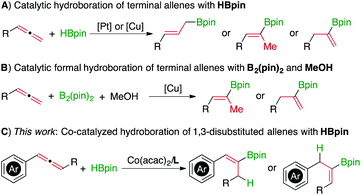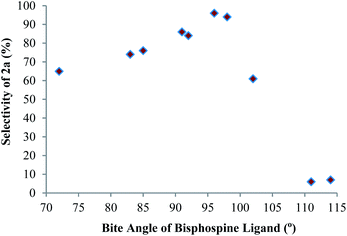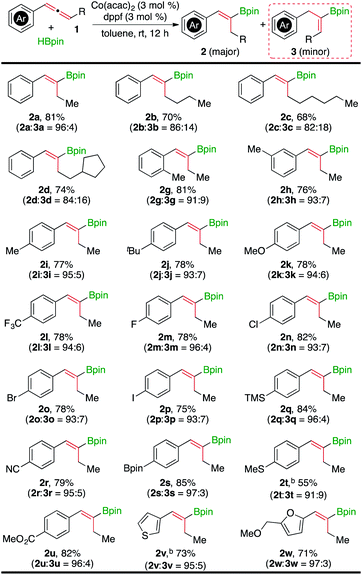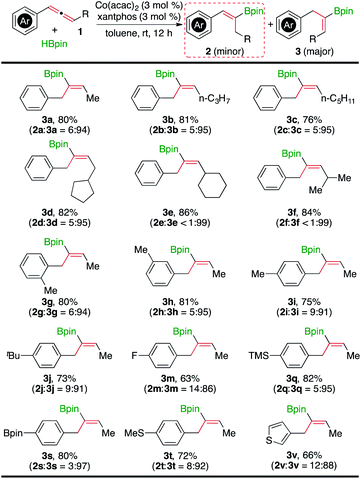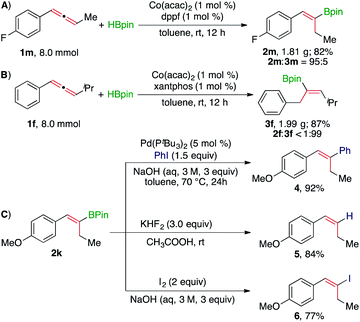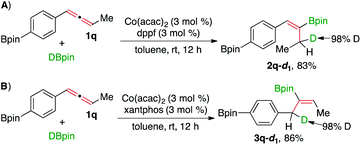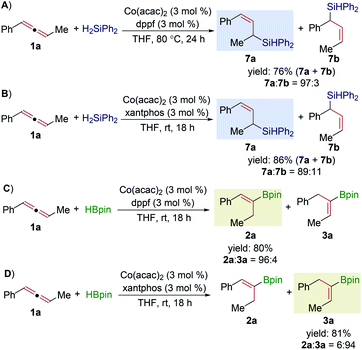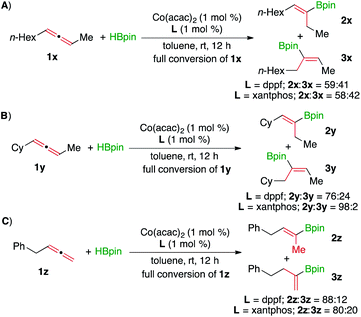 Open Access Article
Open Access ArticleCreative Commons Attribution 3.0 Unported Licence
Ligand-controlled cobalt-catalyzed regiodivergent hydroboration of aryl,alkyl-disubstituted internal allenes†
Caizhi
Wu
and
Shaozhong
Ge
 *
*
Department of Chemistry, National University of Singapore, 3 Science Drive 3, Singapore 117543, Singapore. E-mail: chmgsh@nus.edu.sg
First published on 5th February 2020
Abstract
We report a stereoselective regiodivergent hydroboration of aryl,alkyl-disubstituted internal allenes with pinacolborane (HBpin) in the presence of cobalt catalysts generated from bench-stable Co(acac)2 and bisphosphine ligands. An interesting correlation between the regioselectivity of this hydroboration and the bite angles of bisphosphine ligands was identified. When hydroboration was conducted with cobalt catalysts containing bisphosphines with medium bite angles (e.g. 98° for dppb and 96° for dppf), HBpin was selectively added to the alkyl-substituted double bond. However, HBpin was selectively added to the aryl-substituted double bond when the reactions were conducted with cobalt catalysts containing bisphosphines with large bite angles (e.g. 111° for xantphos and 114° for Nixantphos). A range of internal allenes underwent these Co-catalyzed hydroboration reactions in a regiodivergent manner to yield the corresponding (Z)-alkenylboronates in high isolated yields and with high regioselectivity. These reactions show good functional group compatibility and can be readily scaled up to gram scales without using a dry box. In addition, the comparison of regioselectivity between the Co-catalyzed hydrosilylation and hydroboration reactions of the same allene substrate suggests that this Co-catalyzed regiodivergent hydroboration of allenes proceeds through a Co-Bpin intermediate. Deuterium-labeling experiments suggest that the Co-Bpin intermediates react with allenes to form allylcobalt species which then react with HBpin to release (Z)-alkenylboronate products.
Introduction
Alkenylboronates are synthetically versatile building blocks in organic chemistry because they are stable and non-toxic, and can undergo a range of catalytic cross-coupling reactions to produce stereodefined multisubstituted alkenes.1 The hydroboration of allenes with hydroboranes may be an effective and atom-economical approach to prepare these alkenylboronates. However, the development of selective hydroboration of allenes with hydroboranes to access alkenylboron compounds is very challenging because this reaction can potentially yield a series of organoboron products caused by diverse regio- and stereoselectivity issues. For example, hydroboranes can add to either of the two double bonds of allenes, the stereochemistry of the remaining double bond can be cis or trans, and both monohydroboration and dihydroboration can take place.Allenes can readily undergo uncatalyzed hydroboration with reactive dialkylboranes to afford allylboron or alkenylboron products.2 The regio- and stereo-selectivity for these uncatalyzed hydroboration reactions are generally controlled by allene or dialkylborane reagents. However, the hydroboration of allenes with less reactive dialkoxyboranes, such as pinacolborane (HBpin), does not occur in the absence of metal catalysts. Accordingly, the hydroboration of allenes with HBpin has been studied with platinum and copper catalysts,3 and these reactions have been limited to terminal allenes with a single example employing an internal allene (Scheme 1A).3b Alternatively, formal hydroboration of terminal allenes with B2(pin)2 in the presence of MeOH as a proton source has been achieved with copper catalysts (Scheme 1B).3b,4 To the best of our knowledge, metal catalysts for the hydroboration of 1,3-disubstituted allenes with HBpin to yield alkenylboronates still remain unknown. Driven by our interest in developing cobalt catalysts for selective hydrofunctionalization of unsaturated hydrocarbons,5 we are interested in identifying selective cobalt catalysts for the hydroboration of internal allenes to prepare (Z)-alkenylboronate compounds (Scheme 1C).
In recent years, cobalt complexes have gained increasing attention in hydroboration6 and hydrosilylation7 of unsaturated hydrocarbons,8 and the majority of these reactions occur through cobalt hydride intermediates.9 Very recently, we have reported Co-catalyzed diborylation of alkenes and mechanistic studies suggest the existence of a Co-Bpin species.10 To develop Co-catalyzed hydroboration of internal allenes, we envisioned that the reaction would proceed through borylmetallation to afford alkenylboronates. Herein, we report Co-catalyzed regiodivergent hydroboration of aryl,alkyl-disubstituted internal allenes to prepare (Z)-alkenylboronates, and the regioselectivity of this Co-catalyzed hydroboration is predominantly controlled by bisphosphine ligands employed in these reactions.
Results and discussion
We initiated the studies on the Co-catalyzed hydroboration of allenes by identifying selective and reactive cobalt catalysts for the reaction between buta-1,2-dieny-1-ylbenzene (1a) and HBpin. The catalysts generated in situ from Co(acac)2 and a series of phosphine ligands were tested and the results are summarized in Table 1. In general, these reactions were conducted with allene 1a as a limiting reagent in the presence of 1.1 equivalents of HBpin and 3 mol% catalysts at room temperature for 12 h. This hydroboration reaction yielded two (Z)-alkenylboronate products 2a and 3a, resulting from the addition of HBpin to the alkyl-substituted and aryl-substituted alkene moieties, respectively.| Entry | Ligand | Bite angleb | Conversionc (%) | Ratioc (2a/3a) | Yield (%) |
|---|---|---|---|---|---|
| a Conditions: buta-1,2-dien-1-ylbenzene (0.400 mmol), HBpin (0.440 mmol), Co(acac)2 (12 μmol), ligand (12 μmol), toluene (1 mL), room temperature, and 12 h. b These values are taken from ref. 11, and the bite angle of dpppe has not been reported. c Determined by GC analysis with dodecane as the internal standard. d 6 mol% of ligand was used. | |||||
| 1 | PMe3d | — | >99 | 71![[thin space (1/6-em)]](https://www.rsc.org/images/entities/char_2009.gif) : :![[thin space (1/6-em)]](https://www.rsc.org/images/entities/char_2009.gif) 29 29 |
— |
| 2 | PPh3d | — | >99 | 83![[thin space (1/6-em)]](https://www.rsc.org/images/entities/char_2009.gif) : :![[thin space (1/6-em)]](https://www.rsc.org/images/entities/char_2009.gif) 17 17 |
— |
| 3 | Dppm | 72 | >99 | 65![[thin space (1/6-em)]](https://www.rsc.org/images/entities/char_2009.gif) : :![[thin space (1/6-em)]](https://www.rsc.org/images/entities/char_2009.gif) 35 35 |
— |
| 4 | Dppe | 85 | 18 | 76![[thin space (1/6-em)]](https://www.rsc.org/images/entities/char_2009.gif) : :![[thin space (1/6-em)]](https://www.rsc.org/images/entities/char_2009.gif) 24 24 |
— |
| 5 | Dppp | 91 | 15 | 86![[thin space (1/6-em)]](https://www.rsc.org/images/entities/char_2009.gif) : :![[thin space (1/6-em)]](https://www.rsc.org/images/entities/char_2009.gif) 14 14 |
— |
| 6 | Dppb | 98 | >99 | 94![[thin space (1/6-em)]](https://www.rsc.org/images/entities/char_2009.gif) : :![[thin space (1/6-em)]](https://www.rsc.org/images/entities/char_2009.gif) 6 6 |
78 (2a) |
| 7 | Dpppe | — | >99 | 83![[thin space (1/6-em)]](https://www.rsc.org/images/entities/char_2009.gif) : :![[thin space (1/6-em)]](https://www.rsc.org/images/entities/char_2009.gif) 17 17 |
— |
| 8 | Dppbz | 83 | >99 | 74![[thin space (1/6-em)]](https://www.rsc.org/images/entities/char_2009.gif) : :![[thin space (1/6-em)]](https://www.rsc.org/images/entities/char_2009.gif) 26 26 |
— |
| 9 | rac-binap | 92 | 91 | 84![[thin space (1/6-em)]](https://www.rsc.org/images/entities/char_2009.gif) : :![[thin space (1/6-em)]](https://www.rsc.org/images/entities/char_2009.gif) 16 16 |
— |
| 10 | Dppf | 96 | >99 | 96![[thin space (1/6-em)]](https://www.rsc.org/images/entities/char_2009.gif) : :![[thin space (1/6-em)]](https://www.rsc.org/images/entities/char_2009.gif) 4 4 |
81 (2a) |
| 11 | dpephos | 102 | >99 | 61![[thin space (1/6-em)]](https://www.rsc.org/images/entities/char_2009.gif) : :![[thin space (1/6-em)]](https://www.rsc.org/images/entities/char_2009.gif) 39 39 |
— |
| 12 | Xantphos | 111 | >99 | 6![[thin space (1/6-em)]](https://www.rsc.org/images/entities/char_2009.gif) : :![[thin space (1/6-em)]](https://www.rsc.org/images/entities/char_2009.gif) 94 94 |
80 (3a) |
| 13 | Nixantphos | 114 | >99 | 8![[thin space (1/6-em)]](https://www.rsc.org/images/entities/char_2009.gif) : :![[thin space (1/6-em)]](https://www.rsc.org/images/entities/char_2009.gif) 92 92 |
76 (3a) |

|
|||||
The reactions conducted with monophosphine ligands, such as PMe3 and PPh3, proceeded to complete conversion of 1a, affording a mixture of 2a and 3a with a modest selectivity towards 2a (entries 1 and 2). The catalysts generated by the combination of Co(acac)2 and a series of bisphosphine ligands were subsequently evaluated, and the majority of these cobalt catalysts (entries 3 and 6–13) were highly active for the hydroboration of 1a, except the catalysts containing dppe and dppp ligands (entries 4 and 5). These reactions showed varied selectivity for products 2a and 3a. In addition, we also tested other hydroboranes, such as HB(cat) and 9-BBN, for this Co-catalyzed hydroboration of 1a. However, the reactions with these hydroboranes became less selective and multiple products were obtained (see the ESI† for details).
While studying the ligand effect on the Co-catalyzed hydroboration of allene 1a, we found that the selectivity of this reaction was sensitive to the bite angles of the bisphosphine ligands,11 and the correlation between the selectivity towards product 2a and the bite angles of bisphosphines is depicted in Fig. 1. The selectivity of product 2a increased with the increase of bite angles till the highest selectivity was reached for dppf and dppb ligands with bite angles of 96° and 98°, respectively (entries 6 and 10). However, in the presence of ligands with large bite angles, such as xantphos and Nixantphos, the hydroboration of 1a afforded the (Z)-alkenylboronate 3a as the major product in high isolated yields with high selectivity (entries 12 and 13).
The two internal double bonds in allene 1a have different steric properties and the phenyl-substituted double bond is more sterically hindered than the methyl-substituted one, which means that the methyl-substituted double bond is sterically more accessible for hydroboration. Meanwhile, the phenyl-substituted double bond is more reactive towards hydroboration due to the electron-withdrawing effect of the phenyl group. Therefore, the observed ligand effect (Fig. 1) on the regioselectivity of this Co-catalyzed hydroboration of allene 1a could be explained by the steric and electronic interactions between the substrate 1a and the cobalt catalysts. The data in Fig. 1 suggest that steric effects dominate with bisphosphine ligands with medium bite angles (such as dppb and dppf) and that electronic activation dominates with bisphosphine ligands with large bite angles (such as xantphos and Nixantphos).
Under the identified conditions (entry 10 in Table 1), we studied the scope of internal allenes that undergo this cobalt-catalyzed hydroboration to yield the alkenylboronate 2 and the results are summarized in Fig. 2. In general, a wide range of internal allenes reacted smoothly with HBpin in the presence of 3 mol% Co(acac)2/dppf at room temperature, affording the corresponding (Z)-alkenylboronates (2a–2u) in high yields (55–85%) with high regioselectivity (2![[thin space (1/6-em)]](https://www.rsc.org/images/entities/char_2009.gif) :
:![[thin space (1/6-em)]](https://www.rsc.org/images/entities/char_2009.gif) 3 ratio up to 97
3 ratio up to 97![[thin space (1/6-em)]](https://www.rsc.org/images/entities/char_2009.gif) :
:![[thin space (1/6-em)]](https://www.rsc.org/images/entities/char_2009.gif) 3). The GC-MS analysis on crude mixtures of these reactions showed that the formation of trace amounts (<5%) of the corresponding alkene products resulted from the hydrogenation of allene substrates.
3). The GC-MS analysis on crude mixtures of these reactions showed that the formation of trace amounts (<5%) of the corresponding alkene products resulted from the hydrogenation of allene substrates.
The data in Fig. 2 indicate that the electronic properties of aromatic substituents of the allenes have little influence on the yield and regioselectivity of these Co-catalyzed hydroboration reactions that produce the alkenylboronate 2. For example, allenes containing electron-rich (2k, 2v, and 2w), electron-neutral (2a and 2m), and electron-deficient (2l, 2r, and 2u) aryl groups reacted with similarly high regioselectivity, and the isolated yields of the corresponding (Z)-alkenylboronates are similarly high as well. This is likely because the hydroboration does not take place on the aryl-substituted double bond. As HBpin was added to the alkyl-substituted double bond, the steric properties of the aliphatic groups have a noticeable effect on the regioselectivity. For example, the regioselectivity towards the alkenylboronate 2 decreased when the aliphatic groups became more bulky (2a–2d). Most significantly, hydroboration of the alkyl-substituted double bond was inhibited when the alkyl substituents of allenes were changed to cyclohexyl and isopropyl groups (1e and 1f). Instead, the hydroboration of these two allenes yielded the alkenylboronates 3e and 3f in high yields in the presence of Co(acac)2 and dppf (eqn (1)). The results of these two reactions (eqn (1)) suggest that this Co/dppf-catalyzed hydroboration reaction occurs at the phenyl-activated double bond when both double bonds in allenes become similarly accessible with respect to steric hindrance.
 | (1) |
This Co(acac)2/dppf-catalyzed hydroboration of allenes tolerates a range of functionalities, including ether (2k), chloro (2n), bromo (2o), iodo (2p), trimethylsilyl (2q), cyano (2r), boronic ester (2s), thioether (2t), and carboxylic ester (2u) moieties. In addition, sulfur- and oxygen-containing heteroaryl substituted allenes also reacted with high yields and high regioselectivity (2v and 2w).
Fig. 3 shows the summary of the scope of allenes that undergo hydroboration to yield the alkenylboronate 3 in the presence of Co(acac)2 and xantphos (entry 12 in Table 1). In general, a range of internal allenes underwent this Co-catalyzed hydroboration in the presence of 3 mol% Co(acac)2/xantphos at room temperature, yielding the corresponding (Z)-alkenylboronates in high yields (63–86%) with good regioselectivity (2![[thin space (1/6-em)]](https://www.rsc.org/images/entities/char_2009.gif) :
:![[thin space (1/6-em)]](https://www.rsc.org/images/entities/char_2009.gif) 3 ratio up to 1
3 ratio up to 1![[thin space (1/6-em)]](https://www.rsc.org/images/entities/char_2009.gif) :
:![[thin space (1/6-em)]](https://www.rsc.org/images/entities/char_2009.gif) 99). Different from the Co(acac)2/dppf-catalyzed allene hydroboration, the hydroboration of allenes catalyzed by Co(acac)2 and xantphos could not tolerate chloro-, bromo-, and iodo-substituted aromatic groups, which underwent Co-mediated C-X (X = Cl, Br, or I) borylation under the reaction conditions.12 The GC-MS analysis on the crude reaction mixtures of the Co(acac)2/xantphos-catalyzed hydroboration of allenes 1n–1p indicated the formation of the alkenylboronate 3s.
99). Different from the Co(acac)2/dppf-catalyzed allene hydroboration, the hydroboration of allenes catalyzed by Co(acac)2 and xantphos could not tolerate chloro-, bromo-, and iodo-substituted aromatic groups, which underwent Co-mediated C-X (X = Cl, Br, or I) borylation under the reaction conditions.12 The GC-MS analysis on the crude reaction mixtures of the Co(acac)2/xantphos-catalyzed hydroboration of allenes 1n–1p indicated the formation of the alkenylboronate 3s.
Subsequently, we conducted gram-scale reactions to highlight the utility of these Co-catalyzed protocols for the synthesis of (Z)-alkenylboronates. The hydroboration of allenes 1m and 1f on a 8.0 mmol scale proceeded well in the presence of 1 mol% Co(acac)2/dppf and Co(acac)2/xantphos, yielding the corresponding (Z)-alkenylboronate 2m (1.81 g and 82%, Scheme 2A) and 3f (1.99 g and 87%, Scheme 2B) with similarly high regioselectivity, respectively. In addition, we also showed that the (Z)-alkenylboronate products could be utilized in several organic transformations (Scheme 2C). For example, the (Z)-alkenylboronate 2k could undergo Pd-catalyzed Suzuki–Miyaura coupling with iodobenzene to give a trisubstituted (E)-alkene 4 in 92% yield, protodeboronation to yield a (Z)-alkene 5 in 84% yield, and iodination with I2 to produce an (E)-alkenyl iodide 6 in 77% yield. Thus, this Co-catalyzed allene hydroboration provides a practical method to prepare organic compounds containing stereodefined alkene moieties.
To understand this Co-catalyzed hydroboration of internal allenes, we conducted deuterium-labeling experiments in the presence of both cobalt catalysts, and the results are summarized in Scheme 3. The hydroboration of buta-1,2-dien-1-ylbenzene (1a) with DBpin in the presence of Co(acac)2 and dppf produced 2a-d1, and the deuterium atom of this alkenylboronate was exclusively located at the allylic carbon (Scheme 3A). The same reaction catalyzed by Co(acac)2 and xantphos yielded 3a-d1 with the deuterium atom located at the benzylic carbon (Scheme 3B). Previous studies suggest that the hydroboration reactions of unsaturated hydrocarbons proceed through either a Co–H or a Co-Bpin intermediate. However, the results of these deuterium-labeling experiments could not provide conclusive evidence on the identity of cobalt intermediates in these allene hydroboration reactions.
To reveal the cobalt intermediate in this Co-catalyzed allene hydroboration, we conducted the hydroboration and hydrosilylation reactions of the internal allene 1a in the presence of Co(acac)2/dppf or Co(acac)2/xantphos and compared the regioselectivity of the corresponding reactions (Scheme 4). The hydrosilylation of 1a with Ph2SiH2 conducted with both cobalt catalysts produced the allylsilanes 7a and 7b with high regioselectivity for 7a (Scheme 4A and B). The results of these hydrosilylation reactions of internal allenes are consistent with our previous studies on cobalt-catalyzed hydrosilylation of terminal allenes, which occurs through a Co–H intermediate and produces allylsilanes as major products.13 If the hydroboration reaction of internal allenes occurs through the same Co–H intermediate as in the corresponding hydrosilylation reaction, the hydroboration reactions conducted with both cobalt catalysts will selectively yield allylboronate products. However, the hydroboration of 1a with HBpin by both cobalt catalysts produced the alkenylboronates 2a and 3a as major products (Scheme 4C and D). These results suggest that this Co-catalyzed hydroboration of allenes occurs through a Co-Bpin intermediate.
Based on the results of control experiments and ligand effects on the observed regioselectivity, a plausible catalytic pathway is depicted in Scheme 5 for this Co-catalyzed stereoselective regiodivergent hydrosilylation of aryl,alkyl-1,3-disubstituted allenes. The activation of Co(acac)2 with HBpin in the presence of a bisphsophine ligand generates a cobalt hydride species (L)Co–H,5c which is then converted to a (L)Co-Bpin species by the reaction of the allene 1a and HBpin with the concomitant hydrogenation of the allene.10a Accordingly, the products from the hydrogenation of 1a were detected by GC-MS analysis. Subsequently, the migratory insertion of allenes (for demonstration purposes, only the insertion of one enantiomer of allene 1a is shown in Scheme 5) into this (L)Co-Bpin species produces the allylcobalt intermediates I (for the dppf ligand, steric control) or II (for the xantphos ligand, electronic control), which then react with HBpin to release the alkenylboronate products 2a or 3a and regenerate the catalytically active cobalt boryl intermediate (L)Co-Bpin.
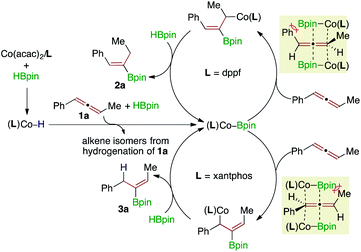 | ||
| Scheme 5 The proposed catalytic cycle for this cobalt-catalyzed regiodivergent hydroboration of aryl,alkyl-1,3-disubstituted allenes. | ||
According to the proposed mechanism, it is anticipated that this Co-catalyzed regiodivergent hydroboration will not be achieved for alkyl,alkyl-1,3-disubstituted allenes because the two double bonds in these allenes are only different in terms of steric hindrance. Indeed, the hydroboration of n-hexyl, methyl-1,3-disubstituted allene 1x yielded alkenylboronates 2x and 3x with similar regioselectivity for both cobalt catalysts (Scheme 6A). Furthermore, increasing the steric difference between the two alkyl substituents allows this hydroboration to proceed selectively on the less hindered double bond of allenes. For example, the hydroboration of cyclohexyl, methyl-1, 3-disubstituted allene 1y took place in the presence of Co(acac)2/xantphos to afford alkenylboronate 2y with 98% regioselectivity (Scheme 6B). In addition, we also tested a terminal allene for this Co-catalyzed hydroboration. Similarly, the hydroboration of terminal allene 1z also occurred on the sterically more accessible bond, yielding alkenylboronate 2z as the major product for both cobalt catalysts (Scheme 6C).
Conclusions
In summary, we have developed an effective protocol for the synthesis of (Z)-alkenylboronates through a ligand-controlled Co-catalyzed stereoselective and regioselective hydroboration of internal allenes. The cobalt catalysts are generated in situ from bench stable Co(acac)2 and dppf or xantphos ligands and are activated by the reaction with HBpin. A variety of internal aryl,alkyl-substituted allenes underwent this hydroboration with HBpin added to the alkyl-substituted or aryl-substituted carbon–carbon double bond in the presence of Co(acac)2/dppf and Co(acac)2/xantphos, respectively. Preliminary mechanistic studies suggest that this Co-catalyzed allene hydroboration proceeds through a cobalt-boryl intermediate and that the regioselectivity of this allene hydroboration is controlled by the synergy between the substrates and cobalt catalysts. This Co-catalyzed allene hydroboration provides a useful approach to access synthetically versatile trisubstituted alkenylboronates with commercially available cobalt catalysts.Experimental details
General procedures for this cobalt-catalyzed stereoselective regiodivergent hydroboration of internal allenes
In an Ar-filled glovebox, Co(acac)2 (12.0 μmol), dppf or xantphos (12 μmol), allene (0.400 mmol), HBpin (0.440 mmol), and toluene (1 mL) were added into a 4 mL screw-capped vial containing a magnetic stirring bar. The vial was sealed with a cap containing a PTFE septum and removed from the dry box. The reaction mixture was stirred at room temperature for 12 h, and the crude product was purified by column chromatography on silica gel with a mixture of hexane and ethyl acetate as the eluent. The conditions for flash chromatography and data for the characterization of the products are listed in the ESI.†Conflicts of interest
There are no conflicts to declare.Acknowledgements
This work was supported by the Ministry of Singapore (R-143-000-A07-112).Notes and references
- For selected reviews, see: (a) N. Miyaura and A. Suzuki, Chem. Rev., 1995, 95, 2457–2483 CrossRef; (b) S. Kotha, K. Lahiri and D. Kashinath, Tetrahedron, 2002, 58, 9633–9695 CrossRef.
- For selected examples, see: (a) H. C. Brown, R. Liotta and G. W. Kramer, J. Am. Chem. Soc., 1979, 101, 2966–2970 CrossRef; (b) C. Sánchez, X. Ariza, J. Cornellà, J. Farràs, J. Garcia and J. Ortiz, Chem.–Eur. J., 2010, 16, 11535–11538 CrossRef PubMed; (c) M. Chen and W. R. Roush, J. Am. Chem. Soc., 2011, 133, 5744–5747 CrossRef PubMed; (d) M. Chen and W. R. Roush, J. Am. Chem. Soc., 2013, 135, 95129517 Search PubMed; (e) L. Yang, Z. Lin, S.-H. Huang and R. Hong, Angew. Chem., Int. Ed., 2016, 55, 6280–6284 CrossRef PubMed; (f) T. Suto, Y. Yanagita, Y. Nagashima, S. Takikawa, Y. Kurosu, N. Matsuo, T. Sato and N. Chida, J. Am. Chem. Soc., 2017, 139, 2952–2955 CrossRef; (g) Y. Nagashima, K. Sasaki, T. Suto, T. Sato and N. Chida, Chem.–Asian J., 2018, 13, 1024–1028 CrossRef.
- (a) Y. Yamamoto, R. Fujikawa and A. Yamada, Chem. Lett., 1999, 28, 1069–1070 CrossRef; (b) K. Semba, M. Shinomiya, T. Fujihara, J. Terao and Y. Tsuji, Chem.–Eur. J., 2013, 19, 7125–7132 CrossRef.
- Alternatively, allkenylboronates can be accessed by the formal hydroboration of allenes with B2pin2 in the presence of methanol as a proton source, see ref. 3b and W. Yuan and S. Ma, Adv. Synth. Catal., 2012, 354, 1867–1872 CrossRef.
- (a) W. J. Teo, C. Wang, Y. W. Tan and S. Ge, Angew. Chem., Int. Ed., 2017, 56, 4328–4332 CrossRef; (b) C. Wang, W. J. Teo and S. Ge, ACS Catal., 2017, 7, 855–863 CrossRef; (c) S. Yu, C. Wu and S. Ge, J. Am. Chem. Soc., 2017, 139, 6526–6529 CrossRef; (d) H. L. Sang, S. Yu and S. Ge, Chem. Sci., 2018, 9, 973–978 RSC; (e) C. Wang and S. Ge, J. Am. Chem. Soc., 2018, 140, 10687–10690 CrossRef; (f) C. Wu, W. J. Teo and S. Ge, ACS Catal., 2018, 8, 5896–5900 CrossRef; (g) H. L. Sang, C. Wu, G. G. D. Phua and S. Ge, ACS Catal., 2019, 9, 10109–10114 CrossRef.
- For selected examples of cobalt-catalyzed hydroboration reactions, see: (a) J. V. Obligacion and P. J. Chirik, J. Am. Chem. Soc., 2013, 135, 19107–19110 CrossRef; (b) L. Zhang, Z. Zuo, X. Leng and Z. Huang, Angew. Chem., Int. Ed., 2014, 53, 2696–2700 CrossRef; (c) L. Zhang, Z. Zuo, X. Wan and Z. Huang, J. Am. Chem. Soc., 2014, 136, 15501–15504 CrossRef CAS; (d) J. V. Obligacion, J. M. Neely, A. N. Yazdani, I. Pappas and P. J. Chirik, J. Am. Chem. Soc., 2015, 137, 5855–5858 CrossRef CAS PubMed; (e) W. N. Palmer, T. Diao, I. Pappas and P. J. Chirik, ACS Catal., 2015, 5, 622–626 CrossRef CAS; (f) L. Zhang and Z. Huang, J. Am. Chem. Soc., 2015, 137, 15600–15603 CrossRef CAS; (g) J. Guo, B. Cheng, X. X. Shen and Z. Lu, J. Am. Chem. Soc., 2017, 139, 15316–15319 CrossRef CAS PubMed; (h) A. D. Ibrahim, S. W. Entsminger and A. R. Fout, ACS Catal., 2017, 7, 3730–3734 CrossRef CAS; (i) J. Peng, J. H. Docherty, A. P. Dominey and S. P. Thomas, Chem. Commun., 2017, 53, 4726–4729 RSC; (j) G. Zhang, J. Wu, S. Li, S. Cass and S. Zheng, Org. Lett., 2018, 20, 7893–7897 CrossRef CAS; (k) R. Agahi, A. J. Challinor, N. B. Carter and S. P. Thomas, Org. Lett., 2019, 21, 993–997 CrossRef CAS; (l) X. Chen, Z. Cheng and Z. Lu, ACS Catal., 2019, 9, 4025–4029 CrossRef CAS.
- For selected examples of cobalt-catalyzed hydrosilylation reactions, see: (a) Z. Mo, J. Xiao, Y. Gao and L. Deng, J. Am. Chem. Soc., 2014, 136, 17414–17417 CrossRef CAS; (b) C. Chen, M. B. Hecht, A. Kavara, W. W. Brennessel, B. Q. Mercado, D. J. Weix and P. L. Holland, J. Am. Chem. Soc., 2015, 137, 13244–13247 CrossRef CAS; (c) X. Du, Y. Zhang, D. Peng and Z. Huang, Angew. Chem., Int. Ed., 2016, 55, 6671–6675 CrossRef CAS; (d) A. D. Ibrahim, S. W. Entsminger, L. Zhu and A. R. Fout, ACS Catal., 2016, 6, 3589–3593 CrossRef CAS; (e) D. Noda, A. Tahara, Y. Sunada and H. Nagashima, J. Am. Chem. Soc., 2016, 138, 2480–2483 CrossRef CAS; (f) A. Rivera-Hernández, B. J. Fallon, S. Ventre, C. Simon, M.-H. Tremblay, G. Gontard, E. Derat, M. Amatore, C. Aubert and M. Petit, Org. Lett., 2016, 18, 4242–4245 CrossRef; (g) C. H. Schuster, T. Diao, I. Pappas and P. J. Chirik, ACS Catal., 2016, 6, 2632–2636 CrossRef CAS; (h) B. Cheng, P. Lu, H. Zhang, X. Cheng and Z. Lu, J. Am. Chem. Soc., 2017, 139, 9439–9442 CrossRef CAS PubMed; (i) J. H. Docherty, J. Peng, A. P. Dominey and S. P. Thomas, Nat. Chem., 2017, 9, 595–600 CrossRef CAS; (j) X. Du, W. Hou, Y. Zhang and Z. Huang, Org. Chem. Front., 2017, 4, 1517–1521 RSC; (k) J. Guo, X. Shen and Z. Lu, Angew. Chem., Int. Ed., 2017, 56, 615–618 CrossRef CAS; (l) B. Raya, S. Jing, V. Balasanthiran and T. V. RajanBabu, ACS Catal., 2017, 7, 2275–2283 CrossRef CAS; (m) R.-H. Li, X.-M. An, Y. Yang, D.-C. Li, Z.-L. Hu and Z.-P. Zhan, Org. Lett., 2018, 20, 5023–5026 CrossRef CAS; (n) S. Zhang, J. J. Ibrahim and Y. Yang, Org. Lett., 2018, 20, 6265–6269 CrossRef CAS; (o) H. Wen, K. Wang, Y. Zhang, G. Liu and Z. Huang, ACS Catal., 2019, 9, 1612–1618 CrossRef CAS.
- For selected reviews of cobalt-catalyzed hydrofunctionalization reactions, see: (a) J. Sun and L. Deng, ACS Catal., 2016, 6, 290–300 CrossRef CAS; (b) X. Du and Z. Huang, ACS Catal., 2017, 7, 1227–1243 CrossRef CAS.
- W. Ai, R. Zhong, X. Liu and Q. Liu, Chem. Rev., 2019, 119, 2876–2953 CrossRef CAS.
- (a) W. J. Teo and S. Ge, Angew. Chem., Int. Ed., 2018, 57, 1654–1658 CrossRef CAS; (b) W. J. Teo and S. Ge, Angew. Chem., Int. Ed., 2018, 57, 12935–12939 CrossRef CAS.
- (a) P. Dierkes and P. W. N. M. van Leeuwen, J. Chem. Soc., Dalton Trans., 1999, 1519–1530 RSC; (b) P. W. N. M. van Leeuwen, P. C. J. Kamer, J. N. H. Reek and P. Dierkes, Chem. Rev., 2000, 100, 2741–2770 CrossRef CAS PubMed.
- For examples of transition metal-catalyzed borylation of aryl halides with dialkoxyboranes, see: (a) M. Murata, S. Watanabe and Y. Masuda, J. Org. Chem., 1997, 62, 6458–6459 CrossRef CAS; (b) O. Baudoin, D. Guénard and F. Guéritte, J. Org. Chem., 2000, 65, 9268–9271 CrossRef CAS PubMed; (c) M. Murata, T. Oyama, S. Watanabe and Y. Masuda, J. Org. Chem., 2000, 65, 164–168 CrossRef CAS PubMed.
- C. Wang, W. J. Teo and S. Ge, Nat. Commun., 2017, 8, 2258 CrossRef CAS PubMed . For a related cobalt-catalyzed allene hydrosilylation, see: Z. Yang, D. Peng, X. Du, Z. Huang and S. Ma, Org. Chem. Front., 2017, 4, 1829–1832 RSC . For a stereo- and regio-selective hydrosilylation of 1,3-disubstituted allenes, see: Z. D. Miller, R. Dorel and J. Montgomery, Angew. Chem., Int. Ed., 2015, 54, 9088–9091 CrossRef PubMed.
Footnote |
| † Electronic supplementary information (ESI) available. See DOI: 10.1039/c9sc06136c |
| This journal is © The Royal Society of Chemistry 2020 |

